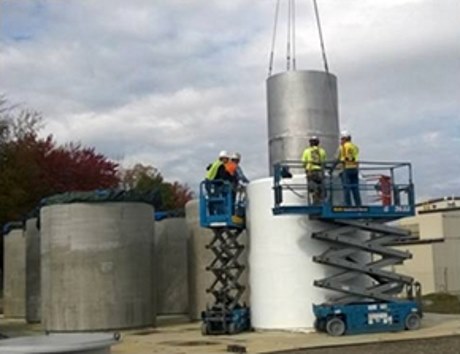High-level waste transfer makes history
12 November 2015
Five canisters of vitrified high-level waste (HLW) from a former nuclear fuel reprocessing plant have been placed in long-term outdoor storage, in a first for US decommissioning.
 |
| An overpack containing waste canisters is loaded into a vertical storage cask (Image: Office of Environmental Management) |
The waste, from the West Valley Demonstration Project (WVDP), is being relocated to an interim storage pad to allow pre-demolition activities to take place within the Main Plant Process Building at the site in New York state. Relocation of all of the HLW at the site - a total of 55 casks - is scheduled to be completed by 2018.
WVDP, the only commercial nuclear fuel reprocessing facility to operate in the USA, ceased operations in 1972. Over 2200 cubic metres of liquid HLW were produced during the facility's six years of reprocessing. From 1996 to 2002 the waste was vitrified and placed into 275 canisters, each three metres tall, and stored inside the main plant building.
The canisters are now being transferred to five-compartment stainless steel overpacks inside vertical storage casks on the interim storage pad. Sixteen of the storage casks, which have a 10 cm thick steel liner and 50 cm of steel-reinforced concrete, have been fabricated on site. The system design is based on used fuel dry cask storage systems in use in the USA and around the world, and the casks have a minimum design life of 50 years.
The cleanup of the WVDP is being conducted by the US Department of Energy's Office of Environmental Management in cooperation with the New York State Energy Research and Development Authority, with CH2M HILL BWXT West Valley as the contractor.
The Office of Environmental Management described the project to move the vitrified HLW as an "unprecedented" accomplishment. "This effort is a culmination of four years' work to begin the safe removal of the HLW canister from the former reprocessing facility, allowing for the eventual demolition of the building," Office of Environmental Management WVDP director Bryan Bower said.
Researched and written
by World Nuclear News